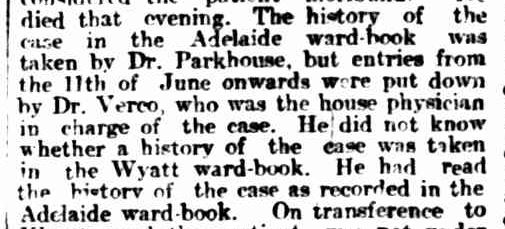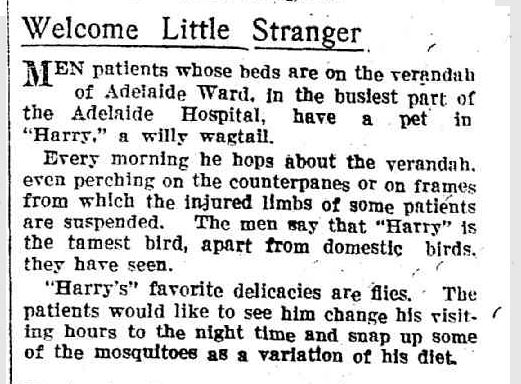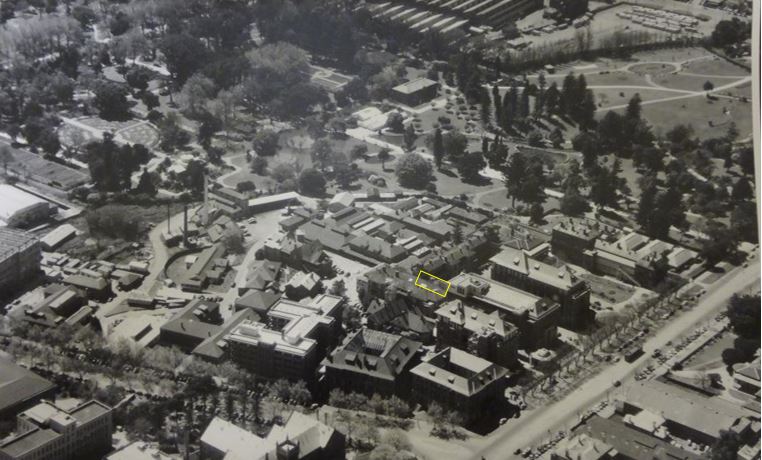When the second purpose-built Adelaide Hospital opened in 1856, only the main central portion and West Wing were built. Adelaide Ward was part of the original 1856 hospital, located in the West Wing. Initially it was known as the Accident Ward, but changed to Adelaide Ward in 1893.

The West Wing was divided into eight ward; seven were for male patients and one ward for female patients. Each ward contained eighteen beds, with one of the wards designated as an accident ward. This was to eventually to become the Adelaide Ward, however for the first 37 years it was known as the Accident Ward.
Adelaide Ward had one entrance door and two fireplaces within the ward. There were sash windows at the side and end of each ward, and two round windows, which turned on pivots and could be opened at any angle. To help with ventilation, Tobin ventilators were placed in the four corners of the ward and were opened and closed by a waist height handle.

There were no toilets within Adelaide Ward but two were located at the entrance of the West Wing. These were ventilated by one small window in each room and there was a plentiful supply of chloride of lime or other disinfectant. The toilets were for the use of all the patients within the West Wing.
In the middle of the ward, there was a slop sink for washing-up purposes. However, by the mid 1880’s these were removed from the West Wing wards as they were messy and smelly and replaced with table and bench seating.

In 1893, at a meeting of the Adelaide Hospital Board of Management, Dr Stirling moved (Dr O’Connell seconded) that the Accident Ward name be changed to the Adelaide Ward. The wards of the hospital were usually given names, following the tradition of British hospitals. Adelaide Ward was named after Queen Adelaide (1792-1849), Queen Consort of King William IV of the United Kingdom.
In 1894, Margaret Graham (later to become Matron Graham) was appointed acting Charge Nurse of Adelaide Ward. During the night, she had three other wards as well as the Adelaide Ward to look after. That meant responsibility for about 70 patients, as well as the ‘front’, admitting any accidents that came in during the night. She was also in charge of the telephone; there was one telephone installed for all of the West Wing.

Each time a patient was admitted to the Adelaide Ward (or any ward within the hospital), the patient history was written by the doctor in charge in the Adelaide Ward Book. This recorded all movements of the patient while in the hospital.

During the 1930s, the Royal Adelaide Hospital had a similar issue to the present day, namely overcrowding, especially in surgical wards such as Adelaide Ward. One of the contributing factors was the inability to transfer patients to other institutions, especially those with spinal injuries. Adelaide Ward had two patients in 1939, one of whom had been there for thirteen months and the other for nine months.

In Patricia Gerrard’s oral history, she recalled which ward she first went to work in as a probationer nurse:
It was Adelaide, I think Adelaide and Albert were next to each other – surgical wards. It was frightening … there were so many patients in one small area. We were so busy and there were black beds pushed in everywhere”.

a fire which occurred in the pantry of Adelaide Ward, caused by a wardsmaid placing some floor wax on the gas, which caught alight. The fire was fortunately extinguished before any real damage was done, and the wardsmaid has been reprimanded by the Matron. A notice will be posted by the Housekeeper instructing that wax is not to be heated before use.
Board minutes 31/05/1944
Until World War II, Adelaide Ward continued to be used as a male surgical/accident ward. During WWII, Adelaide Ward, one of two ground floor wards in the West Wing, were emptied and prepared for emergency admissions in case of air raids or other disasters. However, by 1946, Adelaide Ward was again full to the brim and Lundie Ward (which had been closed) was temporarily opened to take away some of the congestion of Adelaide Ward.
After the McEwin Building was constructed and opened in 1946, it was found that the new building significantly blocked the light to both Adelaide and Albert Wards in the old West Wing. According to the News (7 August 1940) there was only 20 feet between the new building and the existing Albert and Adelaide Wards. New ways to illuminate the wards were sought from the Architect-in-Chief.

The original Adelaide Hospital was demolished in 1963 as part of the redevelopment of the Royal Adelaide Hospital.
Adelaide Ward Alterations and events:
- 1866 The Accident Ward was completely full with patients, the majority had a variety of fractures and contusions;
- 1868 The 18-bed Accident Ward was again at full capacity with 21 beds squashed in;
- 1881 A patient was dismissed from the Accident Ward for using bad language;
- 1890 Slop basins were removed and table and bench seating replaced them;
- 1893 Renaming of the ward from Accident to Adelaide Ward;
- 1896 A Christmas treat was given to the patients of Adelaide Ward in the form of a concert and afternoon tea;
- 1923 Infestation of bugs/vermin and dry rot. The floor of the Adelaide Ward was either renewed, replaced or machine-planed;
- 1928 Radio stations funded the Adelaide Hospital to to be equipped with headphones at each bed so patients can listen to the radio – 3LO Melbourne funded Adelaide Ward;
- 1944 Fire in pantry caused by placing floor wax on the gas;
- 1947 Donation of 10 pounds from patient GD Gill for distribution amongst the nurses of Adelaide Ward in recognition of their kindness and attention to him;
- 1952 The verandahs of Adelaide Ward were enclosed, the ward repainted and bathroom and pantry facilities improved;
- 1952 Adelaide Ward was rearrange ward to accommodate 25 patients; and
- 1962 Adelaide Ward closed.
Written by Margot Way, CALHN Health Museum
(Information sourced from Trove, History Trust, Ancestry, State Library of South Australia and SA Health Museum collection. Copies of all newspaper articles and other relevant documents are available on request)